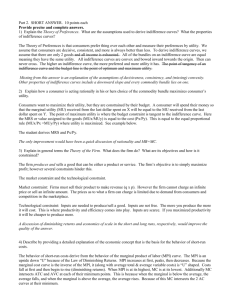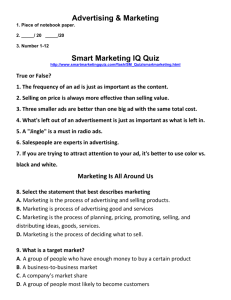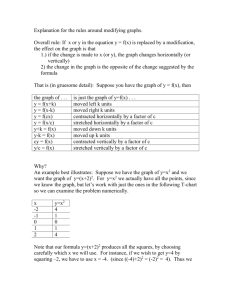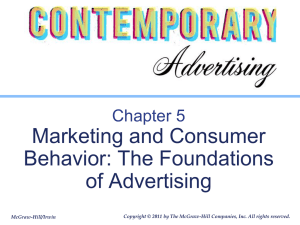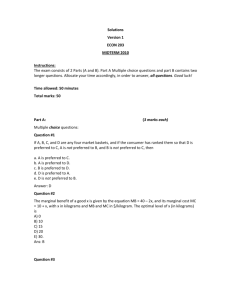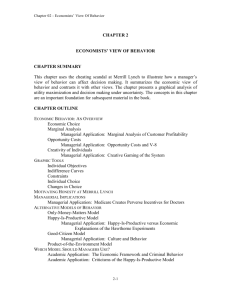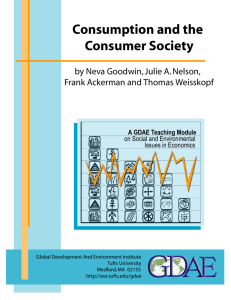Part C: Background to Demand
advertisement
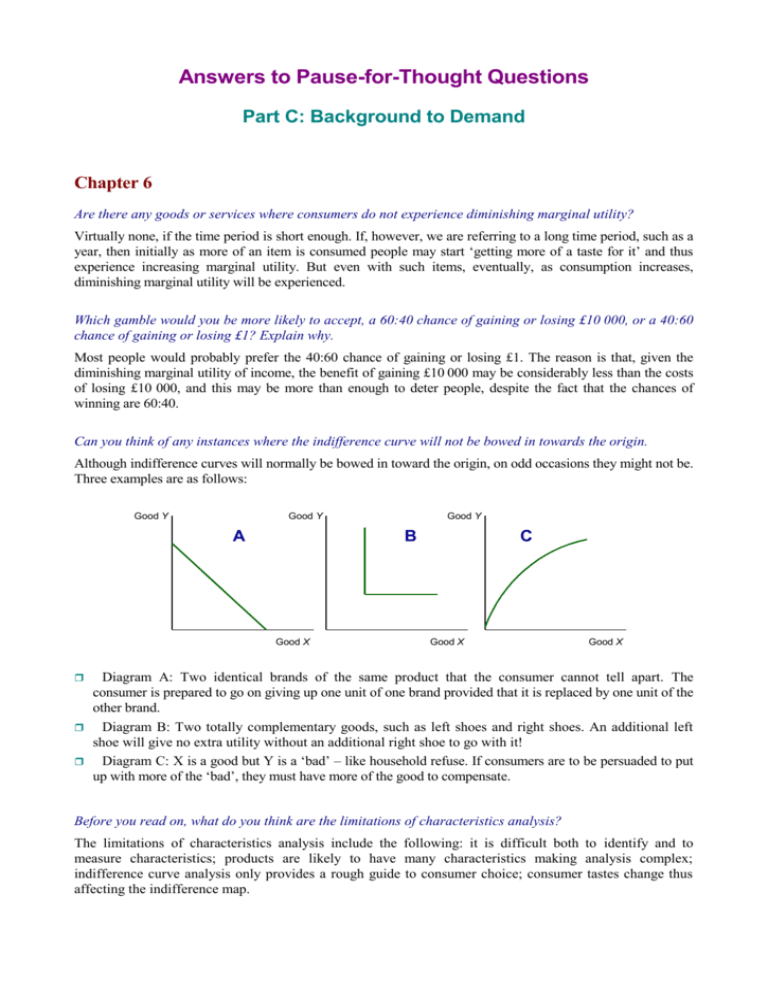
Answers to Pause-for-Thought Questions Part C: Background to Demand Chapter 6 Are there any goods or services where consumers do not experience diminishing marginal utility? Virtually none, if the time period is short enough. If, however, we are referring to a long time period, such as a year, then initially as more of an item is consumed people may start ‘getting more of a taste for it’ and thus experience increasing marginal utility. But even with such items, eventually, as consumption increases, diminishing marginal utility will be experienced. Which gamble would you be more likely to accept, a 60:40 chance of gaining or losing £10 000, or a 40:60 chance of gaining or losing £1? Explain why. Most people would probably prefer the 40:60 chance of gaining or losing £1. The reason is that, given the diminishing marginal utility of income, the benefit of gaining £10 000 may be considerably less than the costs of losing £10 000, and this may be more than enough to deter people, despite the fact that the chances of winning are 60:40. Can you think of any instances where the indifference curve will not be bowed in towards the origin. Although indifference curves will normally be bowed in toward the origin, on odd occasions they might not be. Three examples are as follows: Good Y Good Y A B Good X Good Y C Good X Good X Diagram A: Two identical brands of the same product that the consumer cannot tell apart. The consumer is prepared to go on giving up one unit of one brand provided that it is replaced by one unit of the other brand. Diagram B: Two totally complementary goods, such as left shoes and right shoes. An additional left shoe will give no extra utility without an additional right shoe to go with it! Diagram C: X is a good but Y is a ‘bad’ – like household refuse. If consumers are to be persuaded to put up with more of the ‘bad’, they must have more of the good to compensate. Before you read on, what do you think are the limitations of characteristics analysis? The limitations of characteristics analysis include the following: it is difficult both to identify and to measure characteristics; products are likely to have many characteristics making analysis complex; indifference curve analysis only provides a rough guide to consumer choice; consumer tastes change thus affecting the indifference map. Answers to pause-for-thought questions in Economics for Business (3rd edition), John Sloman and Mark Sutcliffe Chapter 7 Before you read on, try to identify some drawbacks in using market experiments to gather data on consumer behaviour. Possible drawbacks from using market experiments to analyse consumer behaviour include the following: The measured variables may not explain all the variation in demand. Factors such as taste and fashion are very difficult to measure objectively. Many variables shaping consumer demand are linked, such that changes in one variable will affect others. Competition will need to be taken into account, as demand for a firm's product often depends upon the action of competitors. Chapter 8 Identify two other products that are vertically differentiated, two that are horizontally differentiated and two that are both. Two other products that are vertically differentiated might include fruit and vegetable juicing machines, and computers. Two horizontally differentiated products might include cosmetics and breakfast cereal. All four examples given above might also be both vertically and horizontally differentiated. Juicing machines might differ in quality, but a range might be offered at the same price, differing in both finish and design. The same might be said for computers. Cosmetics can differ in quality, and also in respect to colour, perfume and packaging. Breakfast cereals differ both vertically and horizontally depending upon the quality of ingredients and the variety of tastes and textures of the various cereals. What unknown factors is the business likely to face following a diversification strategy? Following a diversification strategy, the biggest unknown factor a business is likely to face is the nature of the new market it enters, and how best, for example, to market and promote its new product, and to deal with other industry competitors. The more diverse the business's diversification, the greater the uncertainty it is likely to face, and the less likely it will be able to transfer its existing knowledge and expertise to its new market environment. Before considering the points listed below, see if you can identify the main arguments both for and against the use of advertising. Arguments in favour of advertising are that it provides information on products, helps introduce new products, helps communicate differences between competing products on the market, encourages competition, and through increased sales might enable a business to drive down costs and enhance its economies of scale. Arguments against advertising are that advertising might be misleading, encourages materialism, creates wants where wants do not exist, uses up scarce resources in unnecessary product promotion, increasing prices for consumers as producers seek to cover their advertising costs, and can be used by established firms as a barrier to the entry of competitors into the market. Advertising is also argued to impose costs on society, with advertisements encroaching on all aspects of life. 2


